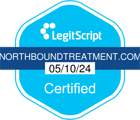No one is immune to drug addiction. It can affect anyone, regardless of age, gender, ethnicity, or income. Moreover, opiate abuse can be particularly detrimental. The CDC (Centers for Disease Control and Prevention) reports upwards of 70,000 drug overdose deaths in the United States in 2017, and 68% of those fatalities involved opiates or opioids. In 2018, 70% of nearly 47,000 overdose deaths involved narcotics.
Northbound Treatment is committed to helping those suffering from opiate addiction achieve sobriety, address their underlying issues, get healthy, and ultimately transform their lives. Excessive and ongoing use of opiates can have severe consequences, which is why seeking support at a drug rehabilitation center is necessary to long term recovery. Understanding the long-term effects of opiates and opioids is a critical component of overcoming opiate/opioid addiction. Here’s what you should know.
Opiates vs. Opioids
Opiates and opioids are highly addictive and powerful painkillers that fall within the narcotic analgesics class of drugs. Although many people use the terms synonymously, they have slightly different definitions. Opium is naturally derived from the poppy plant, and it’s the active ingredient used to make opiates. On the other hand, the active ingredients in opiates are synthetic, as in, they’re created in a lab. Aside from that, opiates and opioids are quite similar and produce essentially the same effect.
Some of the most common opiate drugs include:
- Codeine
- Heroin
- Morphine
- Thebaine
Some of the most common opioid drugs include:
- Darvon (propoxyphene)
- Demerol (meperidine)
- Dilaudid (hydromorphone)
- Fentanyl
- OxyContin (oxycodone)
- Vicodin (hydrocodone)
Narcotic analgesics are prescribed and administered by doctors to treat severe and chronic pain due to injury, surgery, or serious illness. Even with a prescription, signs of opiate use can quickly turn into drug abuse. Outside of prescriptions, many people use pills they receive from someone else, which is not only illegal but also constitutes substance abuse. Using illicit heroin is also extremely dangerous and can result in a criminal charge.
Most people are aware that abusing narcotics is risky, but why, exactly? Apart from legal risks, the long-term effects of opioid use can be damaging to a person’s physical and mental health, as well as their job, personal finances, and relationships.
Long-Term Physical Effects of Opiates
The long-term effects of opioids on the body may include liver damage, digestive issues, suppressed immunity, and sleep-disordered breathing. Some prescription opioids contain acetaminophen, which can cause liver damage if consumed in excess. Many opiate addicts drink alcohol as well, which requires the liver to work extra hard to process both substances and avoid toxicity.
Ongoing opiate use may lead to opioid-induced bowel dysfunction (OIBD). The debilitating condition can involve various digestive problems, such as constipation, vomiting, gastro-oesophageal reflux, bloating, delayed digestion, hard stool, and abdominal pain.
Immunosuppression is one of the long-term effects of opioids that occurs when white blood cells are unable to multiply and mature. White blood cells are essential in the body’s defense against viral and bacterial infections. Also, opiate abuse can inhibit the production of antibodies and cytokines, which the body secretes to defend itself from diseases and harmful bacteria.
Sleep-disordered breathing (sleep apnea) is a sleep condition in which a person has trouble breathing or briefly stops breathing while asleep. Medical research indicates that a majority of chronic opioid users experience sleep apnea.
Long-Term Physical Effects of Opiates & Opioids in Women
Both men and women are susceptible to the effects of opioid abuse outlined above. That said, according to the medical journal Pain Medicine, chronic use may present some additional risks for women.
For women, the long-term implications of opiate use may involve:
- Endocrinopathy (a dysfunctional endocrine gland)
- Fertility issues
- High-risk pregnancies
- Neonatal risks (involving newborn children of mothers who’ve used opioids)
- Difficulty breastfeeding
Additionally, while cardiac issues can occur in men or women who use narcotics for long periods, they may be more prominent in women.
Long-Term Effects of Opiates on the Brain
The most prominent long-term mental effects of opiates include tolerance, withdrawal, mood disorders, and hyperalgesia. If left untreated, these cognitive impacts can be detrimental.
In the short term, using opiates relieves pain and can produce a euphoric effect. As dopamine rushes to the brain, an abnormally high pleasure response is activated — up to ten times as much as the brain is able to produce naturally.
The problem is that opioid users can quickly become accustomed to a dopamine rush, and as a result, they require higher doses of the drug to feel normal. This is referred to as tolerance. The longer someone uses opiates, the more they’ll need to achieve the desired effect. After a while, they won’t feel euphoric anymore, but without narcotics, withdrawal symptoms will kick in.
Opiate Withdrawal
Opiate withdrawal involves both physical and mental symptoms, but it occurs as a result of tolerance, which is one of the long-term effects of opiates. Early symptoms can arise within a few hours and usually involve anxiety and a craving for another dose. After a few more hours, these symptoms heighten, and addicts begin to experience flu-like symptoms, such as sweating, body aches, nausea, or vomiting.
Between one to three days following the last dose of opioids, withdrawal symptoms will hit a peak. Flu-like symptoms will worsen and be accompanied by body tremors, increased heart rate, insomnia, fever, chills, agitation, and feelings of depression. Cravings for narcotics will also reach a peak.
Mood Disorders
With long-term drug use, narcotic painkillers can lead to depression. According to research published in the Journal of the Missouri State Medical Association, when opioids are used for longer than 90 days, a person’s risk for MDD (major depressive disorder) substantially increases. Chronic opiate use is also associated with anxiety.
Opioid-Induced Hyperalgesia
Although it may seem counterintuitive, chronic drug use can also lead to opioid-induced hyperalgesia (OIH), which occurs when a person’s sensitivity to pain increases to abnormal levels. Typically, opiates block receptors that trigger pain signals in the brain. However, in rare instances, long-term opiate abuse may cause the brain to activate other pain signals in an attempt to reverse these effects. OIH can make an individual feel pain in situations they would normally only experience minor discomfort.
Safe Opiate Detox
Upon discontinuing substance abuse, detoxification is the process of eliminating bodily toxins associated with the opiate and opioid drug. Also, both the body and the brain begin to relearn how to function without opiates. While the process is immensely challenging, it’s often a vital component of the journey to recovery. With that said, the long-term effects of use amplify the importance of a safe detox timeline for opiates.
Some people may think that the best way to detox from opiates is at home. However, opioid withdrawal symptoms can be severe, and without medical supervision, they can be dangerous and even fatal. Additionally, the probability of relapse increases with at-home detox, as using again would offer short-term relief.
For many clients, detoxification and stabilization are stepping stones to residential or outpatient rehab. Northbound’s detox program in Orange County offers clinical supervision in a safe and comfortable environment, which effectively prepares our clients for the next phase of addiction treatment.
Opiate Addiction Treatment at Northbound
Some of the effects of opiate abuse will dissipate when an individual stops using the drug. Yet some will remain prominent throughout recovery, while others may linger for years.
The clinical staff at Northbound Treatment has a thorough understanding of the long-term impacts of opiates, all of which are taken into consideration when developing a recovery plan. In addition to an accredited detox program, we offer a wide range of inpatient and outpatient opiate addiction treatment services, as well as addiction support and aftercare services.
Dual Diagnosis Treatment
Many Northbound clients have a dual diagnosis, which is often referred to as co-occurring disorders. This means they struggle with not only drug abuse, but also a mental health condition, such as anxiety, depression, a trauma disorder, obsessive-compulsive disorder (OCD), codependency, bipolar disorder, or borderline personality disorder. In some cases, mental health issues are caused by opiate or opioid addiction, while in others, substance abuse is a coping mechanism for an existing mental condition. Dual diagnosis treatment is an integrated treatment method that addresses all factors.
Through one-on-one sessions, group counseling, and a variety of other evidence-based therapy approaches, patients receive individualized care that aligns with their unique needs, challenges, and goals. With our addiction treatment programs, clients are able to get sober, identify the cause of their substance abuse, learn to cope, develop life skills, heal relationships, and live freely.
If you or someone close to you is addicted to opiate narcotics, don’t delay getting help. Northbound Treatment is admitting new patients every day at our Orange County treatment centers, and we encourage you to reach out as soon as possible. We accept most major insurance plans and can work with you to determine a payment option that fits your unique circumstances.
To begin the admissions process, call Northbound Treatment at (844) 919-0403 or fill out our online form.
Sources:
- Wilson, Nana. “Drug and Opioid-Involved Overdose Deaths — United States, 2017–2018.” MMWR. Morbidity and Mortality Weekly Report 69 (2020): n. pag. , https://www.cdc.gov/mmwr/volumes/69/wr/mm6911a4.htm
- Kurz, Andrea, and Daniel I. Sessler. “Opioid-Induced Bowel Dysfunction: Pathophysiology and Potential New Therapies.” Drugs 63.7 (2003): 649–671. Print., https://www.ncbi.nlm.nih.gov/pubmed/12656645
- Roy, S., and H. H. Loh. “Effects of Opioids on the Immune System.” Neurochemical research 21.11 (1996): 1375–1386. Print., https://www.ncbi.nlm.nih.gov/pubmed/8947928
- Vallejo, Ricardo, Oscar de Leon-Casasola, and Ramsun Benyamin. “Opioid Therapy and Immunosuppression: A Review.” American journal of therapeutics 11.5 (2004): 354. Print., https://journals.lww.com/americantherapeutics/Abstract/2004/09000/Opioid_Therapy_and_Immunosuppression__A_Review.5.aspx
- Darnall, Beth D., Brett R. Stacey, and Roger Chou. “Medical and Psychological Risks and Consequences of Long-Term Opioid Therapy in Women.” Pain medicine (Malden, Mass.) 13.9 (2012): 1181–1211. Print., https://www.ncbi.nlm.nih.gov/pmc/articles/PMC4801003/
- “Opiates | Student Health and Counseling Services.” Ucdavis.edu. N.p., n.d., https://shcs.ucdavis.edu/topics/opiates
- Semenkovich, Katherine et al. “Prescription Opioid Analgesics Increase Risk of Major Depression: New Evidence, Plausible Neurobiological Mechanisms and Management to Achieve Depression Prophylaxis.” Missouri medicine 111.2 (2014): 148–154. Print., https://www.ncbi.nlm.nih.gov/pmc/articles/PMC6179498/










